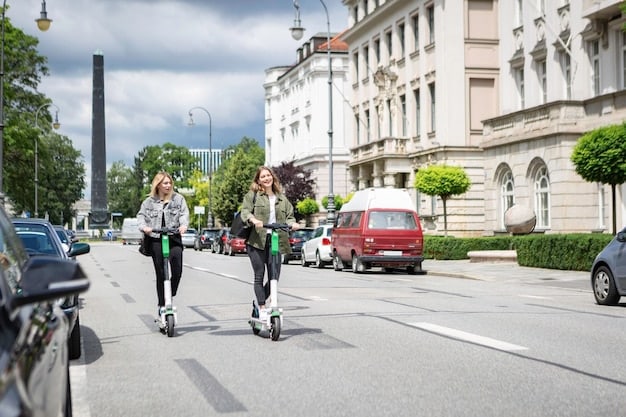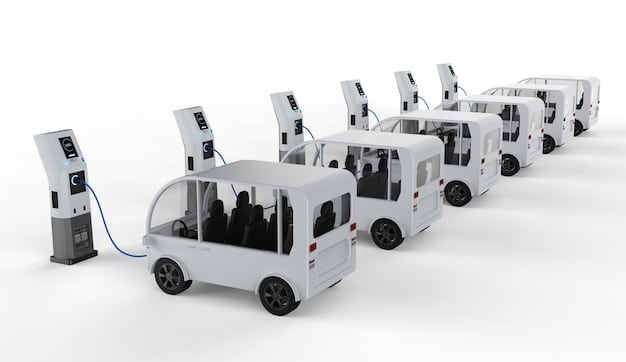Sustainable Transportation: Eco-Friendly Alternatives to Driving Alone

Sustainable transportation involves eco-friendly alternatives like biking, public transit, carpooling, and electric vehicles, reducing carbon emissions and promoting healthier lifestyles, while also saving money and fostering community engagement.
Are you ready to ditch the solo car commute and embrace a greener lifestyle? Sustainable transportation: Explore alternatives to driving alone is not just a trend; it’s a necessity for our planet and our well-being.
Understanding Sustainable Transportation
Sustainable transportation focuses on minimizing environmental impact while meeting our transportation needs. It considers factors like carbon emissions, air quality, and resource consumption.
But why is sustainable transportation so important? Let’s delve into some key reasons:
Reducing Carbon Footprint
Traditional vehicles are major contributors to greenhouse gas emissions, which fuel climate change. Transitioning to sustainable options significantly lowers our carbon footprint.
Improving Air Quality
Vehicle emissions pollute the air, leading to respiratory problems and other health issues. Sustainable transportation methods help improve air quality, especially in urban areas.
Conserving Resources
Sustainable transportation often relies on renewable energy sources and reduces the demand for fossil fuels, thus conserving valuable resources for future generations.
Ultimately, shifting towards sustainable transportation benefits both the environment and our communities by creating healthier, more livable spaces.

Cycling: A Healthy and Green Option
Cycling is one of the most accessible and environmentally friendly transportation options. It’s a great way to incorporate exercise into your daily routine while reducing your carbon footprint.
Considering biking to work or for errands? Here’s why it’s a fantastic choice:
Health Benefits
Cycling is a fantastic cardiovascular workout. It improves your fitness, strengthens your muscles, and boosts your overall health.
Environmental Benefits
Bikes produce zero emissions, helping to reduce air pollution and mitigate climate change.
Cost Savings
Compared to driving, cycling saves you money on fuel, parking, and vehicle maintenance.
- 🚴♀️ Invest in a good quality bike that suits your needs.
- 🚦 Always wear a helmet to ensure your safety.
- 🛣️ Plan your route to take advantage of bike lanes and quieter streets.
- 🔦 Use lights and reflective gear, especially when cycling at night.
Embracing cycling as a transportation option promotes personal health, environmental sustainability, and cost-effectiveness, making it a win-win for everyone.
Public Transportation: Efficient and Economical
Public transportation encompasses buses, trains, subways, and trams. It’s an efficient way to move large numbers of people while minimizing environmental impact.
Why opt for public transit? Here’s a breakdown of its advantages:
Reduced Congestion
Public transport reduces the number of vehicles on the road, alleviating traffic congestion and saving valuable time.
Lower Emissions
Compared to individual cars, buses and trains carry more people per vehicle, resulting in lower emissions per passenger.
Cost-Effective
Using public transportation can be more economical than driving, especially when considering fuel, parking, and maintenance costs.
To maximize the benefits of public transportation, consider these simple steps:
- 🚌 Plan your journey using route planners and apps.
- 🎫 Purchase a monthly pass for cost savings on frequent trips.
- 📱 Utilize public transit apps for real-time updates and schedules.
- 🎧 Make your commute enjoyable with books, podcasts, or music.
By choosing public transportation, you can contribute to a more sustainable and efficient urban environment while saving money and reducing stress.
Carpooling and Ride-Sharing: Sharing the Ride
Carpooling involves sharing a ride with others traveling in the same direction, while ride-sharing uses apps to connect drivers with passengers. Both options reduce the number of cars on the road.
Here’s why carpooling and ride-sharing are gaining popularity:
Reducing Traffic
Fewer cars mean less traffic congestion, making commutes faster and more pleasant for everyone.
Saving Money
Sharing the costs of fuel and parking can lead to significant savings for all participants.
Social Benefits
Carpooling and ride-sharing can foster social connections and build community among commuters.
To make the most of carpooling and ride-sharing, here are some practical tips:
- 🚗 Use carpooling apps to find people heading in the same direction.
- 🤝 Establish clear ground rules with your carpool partners.
- ⏰ Be punctual and respect each other’s time.
- 📱 Ensure all safety protocols are followed when using ride-sharing services.
Carpooling and ride-sharing provide an effective way to reduce traffic, save money, and enjoy a more sociable commute.

Electric and Hybrid Vehicles: The Future of Driving
Electric vehicles (EVs) run entirely on electricity, while hybrid vehicles combine an electric motor with a gasoline engine. Both offer a more sustainable alternative to traditional gasoline cars.
Exploring electric and hybrid options? Here’s what you need to know:
Lower Emissions
EVs produce zero tailpipe emissions, contributing to cleaner air in urban areas. Hybrid vehicles also have lower emissions than gasoline cars.
Reduced Fuel Costs
Electricity is generally cheaper than gasoline, leading to significant savings on fuel costs for EV owners. Hybrid vehicles also offer better fuel economy.
Government Incentives
Many governments offer tax credits and rebates to encourage the adoption of electric and hybrid vehicles.
Choosing an electric or hybrid vehicle involves several considerations:
Charging Infrastructure
Ensure there are sufficient charging stations in your area or consider installing a home charging unit.
Driving Range
Consider the driving range of the vehicle to ensure it meets your daily needs.
Maintenance
EVs typically require less maintenance than gasoline cars due to fewer moving parts.
Investing in an electric or hybrid vehicle is a significant step towards reducing your environmental impact and embracing a more sustainable future.
Planning and Policy: Creating Sustainable Communities
Sustainable transportation isn’t just about individual choices; it also requires thoughtful planning and supportive policies at the community and governmental levels.
Here’s how planning and policy can foster sustainable transportation:
Investing in Infrastructure
Building bike lanes, expanding public transit systems, and creating pedestrian-friendly zones are crucial for encouraging sustainable transportation.
Incentivizing Green Choices
Offering incentives for using public transit, cycling, or driving electric vehicles can motivate people to adopt sustainable practices.
Implementing Regulations
Enacting policies that promote fuel efficiency, reduce emissions, and encourage the use of alternative transportation methods can drive significant change.
To create more sustainable communities, urban planning should prioritize:
Transit-Oriented Development: Designing communities around public transportation hubs to reduce reliance on cars.
Mixed-Use Zoning: Creating neighborhoods where people can live, work, and play without needing to drive long distances.
Complete Streets: Designing streets that are safe and accessible for all users, including pedestrians, cyclists, and motorists.
By integrating sustainable transportation into urban planning and implementing supportive policies, communities can become more livable, environmentally friendly, and economically vibrant.
| Key Point | Brief Description |
|---|---|
| 🚴♀️ Cycling | Healthy, emission-free, and cost-effective transportation. |
| 🚌 Public Transportation | Reduces congestion and emissions, and is cost-effective. |
| 🚗 Carpooling | Saves money, reduces traffic, and fosters community. |
| ⚡ Electric Vehicles | Low emissions, reduced fuel costs, and government incentives. |
FAQ: Sustainable Transportation
▼
Sustainable transportation refers to methods of moving people and goods that minimize environmental impact and promote social equity and economic viability.
▼
It reduces carbon emissions, improves air quality, conserves resources, and promotes healthier lifestyles, contributing to a more sustainable future.
▼
Consider cycling, using public transportation, carpooling, or switching to an electric or hybrid vehicle to reduce your carbon footprint.
▼
Electric vehicles produce zero tailpipe emissions, have lower fuel costs, and often come with government incentives to encourage adoption.
▼
Cities invest in bike lanes, expand public transit, offer incentives for green choices, and implement regulations to encourage sustainable transportation practices.
Conclusion
Embracing sustainable transportation is a crucial step towards a healthier planet and more livable communities. By exploring alternatives to driving alone, such as cycling, public transportation, carpooling, and electric vehicles, we can significantly reduce our environmental impact and improve our quality of life, one journey at a time.





